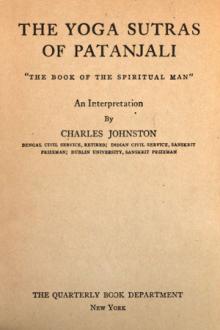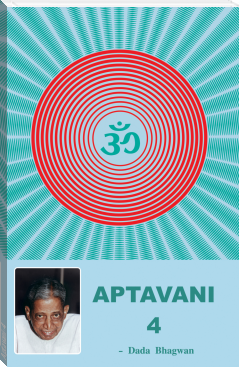The Yoga Sutras of Patanjali by Patañjali (color ebook reader .txt) 📖

- Author: Patañjali
- Performer: -
Book online «The Yoga Sutras of Patanjali by Patañjali (color ebook reader .txt) 📖». Author Patañjali
In like manner, the same overruling selective power, which is a ray of the Higher Self, gathers together from different births and times and places those mind-images which are conformable, and may be grouped in the frame of a single life or a single event. Through this grouping, visible bodily conditions or outward circumstances are brought about, and by these the soul is taught and trained.
Just as the dynamic mind-images of desire ripen out in bodily conditions and circumstances, so the far more dynamic powers of aspiration, wherein the soul reaches toward the Eternal, have their fruition in a finer world, building the vesture of the spiritual man.
10. The series of dynamic mind-images is beginningless, because Desire is everlasting.
The whole series of dynamic mind-images, which make up the entire history of the personal man, is a part of the mechanism which the Self employs, to mirror itself in a reflection, to embody its powers in an outward form, to the end of self-expression, selfrealization, self-knowledge. Therefore the initial impulse behind these dynamic mind-images comes from the Self and is the descending ray of the Self; so that it cannot be said that there is any first member of the series of images, from which the rest arose. The impulse is beginningless, since it comes from the Self, which is from everlasting. Desire is not to cease; it is to turn to the Eternal, and so become aspiration.
11. Since the dynamic mind-images are held together by impulses of desire, by the wish for personal reward, by the substratum of mental habit, by the support of outer things desired; therefore, when these cease, the self reproduction of dynamic mind-images ceases.
We are still concerned with the personal life in its bodily vesture, and with the process whereby the forces which have upheld it are gradually transferred to the life of the spiritual man, and build up for him his finer vesture in a finer world.
How is the current to be changed? How is the flow of self-reproductive mind-images, which have built the conditions of life after life in this world of bondage, to be checked, that the time of imprisonment may come to an end, the day of liberation dawn?
The answer is given in the Sutra just translated. The driving-force is withdrawn and directed to the upbuilding of the spiritual body.
When the building impulses and forces are withdrawn, the tendency to manifest a new psychical body, a new body of bondage, ceases with them.
12. The difference between that which is past and that which is not yet come, according to their natures, depends on the difference of phase of their properties.
Here we come to a high and difficult matter, which has always been held to be of great moment in the Eastern wisdom: the thought that the division of time into past, present and future is, in great measure, an illusion; that past, present, future all dwell together in the eternal Now.
The discernment of this truth has been held to be so necessarily a part of wisdom, that one of the names of the Enlightened is: “he who has passed beyond the three times: past, present, future.”
So the Western Master said: “Before Abraham was, I am”; and again, “I am with you always, unto the end of the world”; using the eternal present for past and future alike. With the same purpose, the Master speaks of himself as “the alpha and the omega, the beginning and the end, the first and the last.”
And a Master of our own days writes: “I feel even irritated at having to use these three clumsy words—past, present, and future. Miserable concepts of the objective phases of the subjective whole, they are about as ill adapted for the purpose, as an axe for fine carving.”
In the eternal Now, both past and future are consummated.
Bjorklund, the Swedish philosopher, has well stated the same truth:
“Neither past nor future can exist to God; He lives undividedly, without limitations, and needs not, as man, to plot out his existence in a series of moments. Eternity then is not identical with unending time; it is a different form of existence, related to time as the perfect to the imperfect … Man as an entity for himself must have the natural limitations for the part. Conceived by God, man is eternal in the divine sense, but conceived, by himself, man’s eternal life is clothed in the limitations we call time. The eternal is a constant present without beginning or end, without past or future.”
13. These properties, whether manifest or latent, are of the nature of the Three Potencies.
The Three Potencies are the three manifested modifications of the one primal material, which stands opposite to perceiving consciousness. These Three Potencies are called Substance, Force, Darkness; or viewed rather for their moral colouring, Goodness, Passion, Inertness. Every material manifestation is a projection of substance into the empty space of darkness. Every mental state is either good, or passional, or inert. So, whether subjective or objective, latent or manifest, all things that present themselves to the perceiving consciousness are compounded of these three. This is a fundamental doctrine of the Sankhya system.
14. The external manifestation of an object takes place when the transformations ore in the same phase.
We should be inclined to express the same law by saying, for example, that a sound is audible, when it consists of vibrations within the compass of the auditory nerve; that an object is visible, when either directly or by reflection, it sends forth luminiferous vibrations within the compass of the retina and the optic nerve. Vibrations below or above that compass make no impression at all, and the object remains invisible; as, for example, a kettle of boiling water in a dark room, though the kettle is sending forth heat vibrations closely akin to light.
So, when the vibrations of the object and those of the perceptive power are in the same phase, the external manifestation of the object takes place.
There seems to be a further suggestion that the appearance of an object in the “present,” or its remaining hid in the “past,” or “future,” is likewise a question of phase, and, just as the range of vibrations perceived might be increased by the development of finer senses, so the perception of things past, and things to come, may be easy from a higher point of view.
15. The paths of material things and of states of consciousness are distinct, as is manifest from the fact that the same object may produce different impressions in different minds.
Having shown that our bodily condition and circumstances depend on Karma, while Karma depends on perception and will, the sage recognizes the fact that from this may be drawn the false deduction that material things are in no wise different from states of mind. The same thought has occurred, and still occurs, to all philosophers; and, by various reasonings, they all come to the same wise conclusion; that the material world is not made by the mood of any human mind, but is rather the manifestation of the totality of invisible Being, whether we call this Mahat, with the ancients, or Ether, with the moderns.
16. Nor do material objects depend upon a single mind, for how could they remain objective to others, if that mind ceased to think of them?
This is but a further development of the thought of the preceding Sutra, carrying on the thought that, while the universe is spiritual, yet its material expression is ordered, consistent, ruled by law, not subject to the whims or affirmations of a single mind. Unwelcome material things may be escaped by spiritual growth, by rising to a realm above them, and not by denying their existence on their own plane. So that our system is neither materialistic, nor idealistic in the extreme sense, but rather intuitional and spiritual, holding that matter is the manifestation of spirit as a whole, a reflection or externalization of spirit, and, like spirit, everywhere obedient to law. The path of liberation is not through denial of matter but through denial of the wills of self, through obedience, and that aspiration which builds the vesture of the spiritual man.
17. An object is perceived, or not perceived, according as the mind is, or is not, tinged with the colour of the object.
The simplest manifestation of this is the matter of attention. Our minds apprehend what they wish to apprehend; all else passes unnoticed, or, on the other hand, we perceive what we resent, as, for example, the noise of a passing train; while others, used to the sound, do not notice it at all.
But the deeper meaning is, that out of the vast totality of objects ever present in the universe, the mind perceives only those which conform to the hue of its Karma. The rest remain unseen, even though close at hand.
This spiritual law has been well expressed by Emerson:
“Through solidest eternal things the man finds his road as if they did not subsist, and does not once suspect their being. As soon as he needs a new object, suddenly he beholds it, and no longer attempts to pass through it, but takes another way. When he has exhausted for the time the nourishment to be drawn from any one person or thing, that object is withdrawn from his observation, and though still in his immediate neighbourhood, he does not suspect its presence. Nothing is dead. Men feign themselves dead, and endure mock funerals and mournful obituaries, and there they stand looking out of the window, sound and well, in some new and strange disguise. Jesus is not dead, he is very well alive: nor John, nor Paul, nor Mahomet, nor Aristotle; at times we believe we have seen them all, and could easily tell the names under which they go.”
18. The movements of the psychic nature are perpetually objects of perception, since the Spiritual Man, who is the lord of them, remains unchanging.
Here is teaching of the utmost import, both for understanding and for practice.
To the psychic nature belong all the ebb and flow of emotion, all hoping and fearing, desire and hate: the things that make the multitude of men and women deem themselves happy or miserable. To it also belong the measuring and comparing, the doubt and questioning, which, for the same multitude, make up mental life. So that there results the emotion-soaked personality, with its dark and narrow view of life: the shivering, terror driven personality that is life itself for all but all of mankind.
Yet the personality is not the true man, not the living soul at all, but only a spectacle which the true man observes. Let us under stand this, therefore, and draw ourselves up inwardly to the height of the Spiritual Man, who, standing in the quiet light of the Eternal, looks down serene upon this turmoil of the outer life.
One first masters the personality, the “mind,” by thus looking down on it from above, from within; by steadily watching its ebb and flow, as objective, outward, and therefore not the real Self. This standing back is the first step, detachment. The second, to maintain the vantage-ground thus gained, is recollection.
19. The Mind is not self-luminous, since it can be seen as an object.
This is a further step toward overthrowing the tyranny of the “mind”: the psychic nature of emotion and mental measuring. This psychic self, the personality, claims to be absolute, asserting that life is for it and through it; it seeks to impose on the whole being of man its narrow, materialistic, faithless view of life and the universe; it would clip the wings of the soaring Soul. But the Soul dethrones the tyrant, by perceiving and steadily





Comments (0)